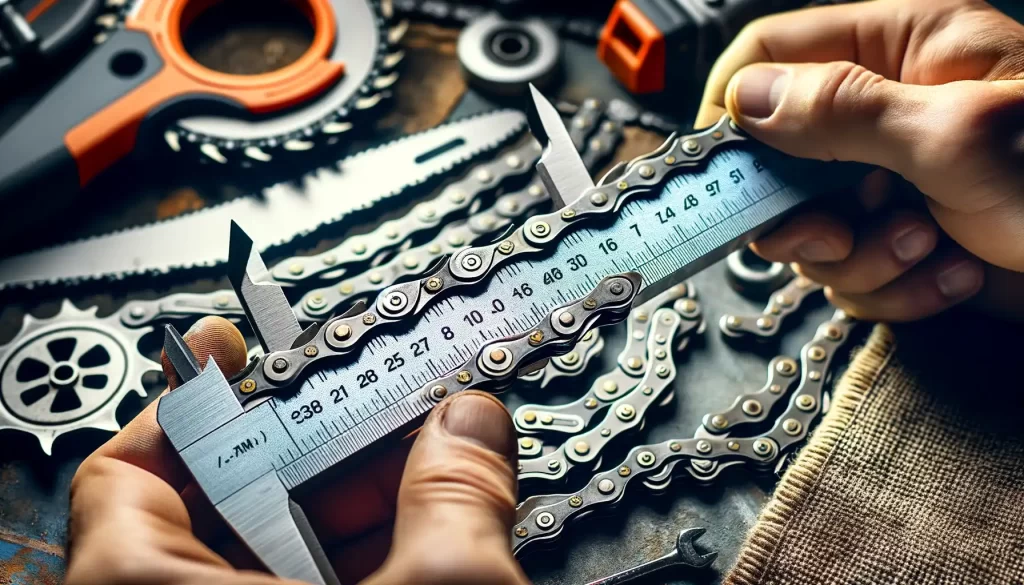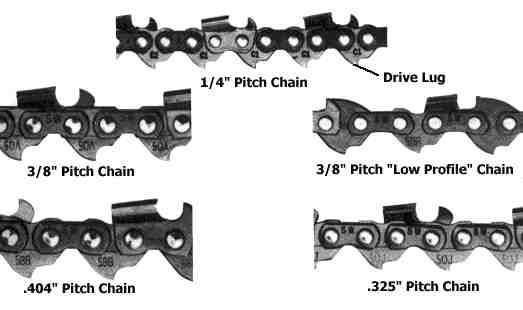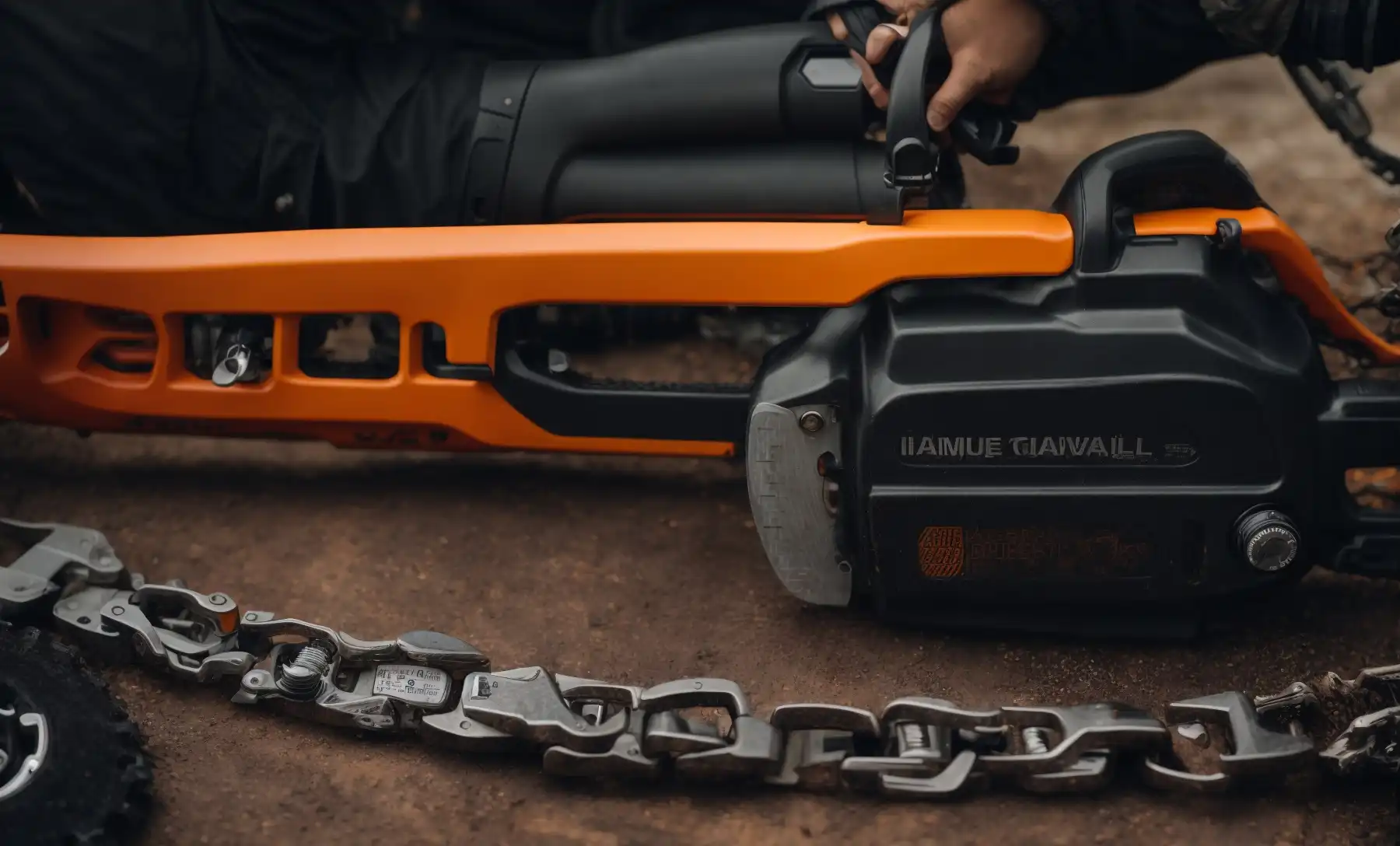To measure a chainsaw chain, count its drive links and note the pitch and gauge. Ensure the chainsaw is powered off before measuring for safety.
Measuring a chainsaw chain accurately is crucial for maintenance and when you need to find a replacement. A chain that fits perfectly ensures both safety and efficiency while operating the chainsaw. Before starting the measurement process, disengage the chainsaw’s brake and remove the chain from the bar to prevent any accidents.
This direct approach helps professionals and DIY enthusiasts maintain their equipment in top condition. By understanding the specifics of your chainsaw chain, you can make informed decisions when purchasing new chains or assessing the condition of your current one. Keep in mind, using the correct size chain is vital for effective cutting and prolonging the life of your chainsaw.
About Measure a Chainsaw Chain
Measuring a chainsaw chain correctly ensures your chainsaw works safely and efficiently. Precision in chain measurement avoids accidents and poor cutting performance. This guide helps you grasp the basics of chainsaw chain measurement.
Understanding Chainsaw Chain Terminology
Knowing the right terms is key to measuring your chainsaw chain. Chainsaws use different terms like ‘pitch’, ‘gauge’, and ‘drive link count.’ These terms describe the size and type of chain your chainsaw needs.
- Pitch: Distance between three consecutive rivets divided by two.
- Gauge: Thickness of the drive link where it fits into the guide bar.
- Drive Link Count: Number of drive links that sit within the guide bar.
The Importance of Accurate Chain Measurement
Accurate measurement is crucial. A chain that’s too long or short can be dangerous. It might slip off or cause kickback. Ensuring a perfect fit promotes safety and extends your chainsaw’s life.
Measure twice, cut once is the golden rule. Correct chain measurement saves time and money in the long run.
Overview of Different Chainsaw Chain Types
Chainsaws come with various chain types, each designed for specific tasks. Knowing the differences helps in selecting the right chain.
| Type | Use |
|---|---|
| Full-Chisel | Fast cutting through hardwood |
| Semi-Chisel | Durable, stays sharp longer in softwood |
| Low-Profile | Less kickback, good for home use |
Understand your cutting needs to choose the ideal chain type. Whether dealing with softwood or hardwood, the correct chain type makes a difference in ease and safety.
Tools and Preparation For Measuring a Chainsaw Chain
Chainsaw chain measurement is crucial for maintenance and replacement. The right tools and preparation ensure accuracy and safety. This guide covers the essentials of measuring a chainsaw chain correctly.

Essential Tools For Chain Measurement
- Tape Measure: For length accuracy
- Caliper or Ruler: To measure chain pitch and gauge
- Pen and Paper: To note measurements
Safety Considerations Before Starting
Safety cannot be overemphasized. Ensure these safety measures are in place:
- Wear gloves to protect hands
- Engage the chainsaw’s brake
- Work in a well-lit area
Preparing the Chainsaw For Measurement
Prepare your chainsaw for measurement with these steps:
| Step | Action |
|---|---|
| 1 | Power off the chainsaw |
| 2 | Clean the chain to see markings |
| 3 | Secure the chainsaw to prevent movement |
Determining the Chain Pitch and Gauge
Chainsaws demand precision for efficient and safe operation. Properly measuring a chainsaw chain is vital. The pitch and gauge of a chain ensure the right fit and performance. This post guides you in determining these key chain dimensions.
What Is Chain Pitch and Why It Matters
The chain pitch defines the size of your chainsaw chain. It’s the distance between any three consecutive rivets divided by two.
Precise pitch measurement guarantees compatibility with the chainsaw’s bar. An incorrect pitch can cause serious safety issues and poor cutting performance.
Step-by-step Guide to Measuring Chain Pitch
- Identify the rivets on your chain. These are the small, round pins holding the chain together.
- Measure the distance from the center of one rivet to the center of the third rivet.
- Divide this number by two. This result is your chain’s pitch.
- Refer to your chainsaw manual for the recommended pitch or match it with a new chain.
How to Measure the Chain Gauge Accurately
The chain gauge indicates the thickness of the drive links. It’s essential for secure bar fitting.
- Locate a drive link, which sits inside the chainsaw bar.
- Use a precise tool, like a caliper, to measure the drive link’s thickness.
- Compare this measurement to the gauge sizes: .043″, .050″, .058″, or .063″.
- Choose a chain with a matching gauge.
Accurate measurements of pitch and gauge ensure peak chainsaw efficiency. Regular checks keep your chainsaw in top condition.
Measuring the Chainsaw Chain Length
Knowing the correct length of your chainsaw chain is crucial. A perfectly measured chain ensures efficient cutting and safety. Let’s dive into how to get that accurate measurement. Start with the total number of drive links and understand their connection to chain length. Then, follow a simple process to measure the chain.
Calculating the Total Number of Drive Links
The number of drive links on your chainsaw chain is the first step. Drive links are the teeth on the inside of the chain that slot into the guide bar.
Here’s how to count them:
- Remove the chain from the chainsaw.
- Lay it on a flat surface.
- Count each drive link until you reach the end.
This count will be critical for determining the right length.
Understanding the Relationship Between Drive Links and Chain Length
The length of the chainsaw chain correlates with the number of drive links. More drive links mean a longer chain. Here’s what you need to know:
- Each chain pitch and gauge combination has a specific drive link count.
- A chain’s pitch, which is the distance between three consecutive rivets divided by two, affects the link count.
- The gauge is the thickness of the drive link where it fits into the bar.
Instructions For Measuring the Overall Chain Length
To measure the overall chain length, follow these steps:
- Prepare a tape measure or a ruler.
- Stretch out the chain fully on a flat surface.
- Measure from one end to the other.
- Note the measurement and check against the drive link count for accuracy.
For an exact measurement, check the manufacturer’s specifications or compare your count and length with a size chart specific to your chainsaw’s brand and model.
Adjusting and Replacing Chainsaw Chains
Expert maintenance ensures your chainsaw works safely and efficiently. Proper chain tension and timely replacement are key. Learn to adjust and replace your chainsaw chain with ease.
How to Adjust a Chainsaw Chain for Optimal Performance
Correct tension on a chainsaw chain reduces wear and danger. Follow these steps:
- Wear gloves. Protect your hands from sharp edges.
- Locate the tensioning screw. It’s near the chainsaw’s guide bar.
- Turn the screw clockwise to tighten. Use the tool provided with your saw.
- Lift the chain.
- Check the slack. The chain should slightly lift but not leave the bar.
- Recheck tension after a few cuts.
When to Consider Replacing Your Chainsaw Chain
Chainsaw chains don’t last forever. Look for these signs:
- Dull or damaged teeth.
- Chain stretches and lacks tension.
- Saw dust turns into fine powder.
- Chain cuts unevenly or pulls to one side.
Guide to Selecting the Right Chain for Your Chainsaw
Choose a compatible chain for the best experience. Check these specifications:
| Pitch | Gauge | Drive Links Count |
|---|---|---|
| Distance between three consecutive rivets divided by two. | Thickness of the drive link where it fits into the guide bar. | Total count in your current chain. Match exactly. |

Conclusion
Accurately measuring your chainsaw chain ensures peak performance and safety. This simple guide provides the clarity needed for a proper fit every time. Remember, match pitch, gauge, and drive link count to your saw’s requirements. Embrace this knowledge for efficient cutting and a prolonged chainsaw life.
Got a thing for chainsaws? You’re in good company at Chainsaw Hive. Our Knowledge section is chock-full of the good stuff to keep your passion fueled. Don’t miss out – there’s more where that came from! Happy sawing!
